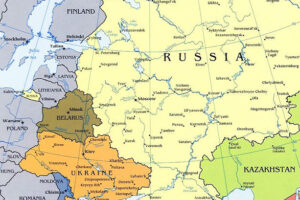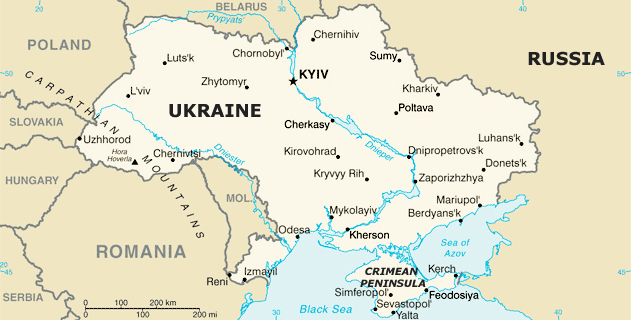Ukraine-Russia: Headlines get worse but gas is the key indicator

(Business New Europe – bne.eu – Chris Weafer, Macro Advisory – April 14, 2014)
“Let me warn you, if you start chasing after views, you’ll be left without bread and without views”
Nikolai Gogol
Weekend headlines will add to market nervousness today. The headlines from east Ukraine over the weekend will unsettle markets at the start of trading today. The situation is clearly very dangerous and largely unpredictable. But, despite the ratcheting-up of rhetoric from all sides, the evidence still suggests that Russia will not invade. Instead Russia has always supported the protestors’ demands for some form of federalism in the east.
Sanctions risk if the West blames Moscow. The key risk is whether the US/EU believes Moscow is behind the escalation of violence in the east and, even without a military incursion, moves to the more serious economy and trade disrupting sanctions. This question will be the focus of investor attention over the coming days.
Diplomatic efforts were starting to pick-up. As the crisis escalates on the ground, the foreign ministers from Russia, Ukraine and the US/EU are due to meet for the first time in Geneva on Thursday to discuss the crisis. That is the same day President Putin is scheduled to hold his annual televised Q&A session and Ukraine and the economy are expected to dominate. If that planed meeting is cancelled this would be taken as a very negative signal by investors and we would see a further step down in equities, the ruble, and in debt markets.
How the gas dispute proceeds will provide a good indicator. Based on that critical assumption, i.e. no military action and no increase in sanctions against Russia that such a move would certainly provoke, investors need to follow the gas dispute closely. What happens here will provide the best indicator of whether political pragmatism is emerging as the backdrop to the headline crisis or whether the dispute either remains deadlocked or could be deteriorating. In the case of the former, long-only investors should start buying into selected equities and sovereign debt while, in the case of the latter, they should continue to stand-off.
The existing debt and tariff are the key points. We are specifically looking at whether there will be an agreement to schedule the payment of the existing $2.2 billion debt and either a reduction of the gas tariff to the EU average $380 p/’1000 cm and/or an indication that Gazprom will start negotiations for a new tariff contract.
Gas and politics remain interlinked. If we have now passed the worst of the political crisis, notwithstanding the east Ukraine headlines, then a gas deal is very likely. If the military risk is still real then we will not see a gas deal.
Gazprom shares reflect the sentiment shifts. We prefer Gazprom over the state banks as the best proxy, amongst the blue chips, to position for an improvement in sentiment and a return of the big EM investment funds in the summer. The long-awaited gas deal with China is now almost certain to be agreed upon during President Putin’s visit to China in May. The expanded Russia-China investment and trade relationship is then likely to be a key theme at the May 22nd-24th St. Petersburg Economic Forum.
An important week for diplomacy. Short-term the headlines and TV footage from east Ukraine will continue to keep most of the big EM investment funds nervous of Russia risk until there is a clear political breakthrough. Our core position has been that this may not happen until after the May 25th presidential election and a possible engagement between the new president and Moscow. But a clear agreement on the gas issues or positive signals from the four-way talks, due to start in Geneva on Thursday, may encourage more investors to take advantage of cheap valuations sooner (see scenarios table below).
Some positive indicators. The fact that Russia has started to return Ukraine’s navy vessels, which were trapped as part of the blockade of Crimea ports, is a positive indicator that the Kremlin is looking for a political compromise rather than further confrontation. It is reported that up to 70 vessels will be transferred to Ukraine in the coming days.
Self-sanctions have hurt more than the official sanctions. The impact of existing sanctions, especially the self-sanctions which have gone well beyond that required by the US and EU regulations as major companies deem it prudent to delay investment and trade deals in Russia, is not negligible. It has always been our position that concern over the negative impact on the ruble and the domestic economy would place a limit on further direct Russian actions in Ukraine.
Capital flight was less than the worst case scenario. The capital flight total for Qtr 1 was $51 bln and while large compared to last year the total was well short of the worst case scenarios suggested in early March. The Qtr 1 current account surplus gained almost 14% on the same quarter last year and the trade balance was up 8%. But inflation is now back at 7% on an annualized basis and, unless that is brought down towards 6%, the hoped for economic recovery in the 2nd half may fail.
Still many questions about the Ukraine bailout. Ukraine’s financial position is becoming even more precarious. The initial euphoria generated by the IMF agreement is starting to fade. The emerging realities are;
- Ukraine will only get $7 billion of the $14-$18 billion promised by the IMF team this year, albeit that should be available before the May 25th election.
- There is much less clarity on who will provide the additional $9-$13 billion, i.e. to bring the total foreign aid package up to the $27 billion level. The US has so far only provided a $1 billion loan “guarantee” plus $150 million of direct aid. Canada has promised a “few hundred” million dollars of aid. So far there are no hard numbers coming from the EU.
- A debt restructuring in Ukraine is still far from avoidable. This may well be part of the conditions attached to EU aid and, if not, the risk remains high for 2015.
- It is becoming clearer that Ukraine’s economy is deteriorating and political risks will likely continue to defer hopes of recovery. The total size of the external aid package, i.e. assuming the gas debt is covered plus the increasing budget deficit, over the next 24 months is now more likely to to climb to $35-$40 billion rather than the $27 billion indicated earlier this year.
A clear leader in the Ukraine election. Opinion polls show that Petro Poroshenko is now clear favourite to win the presidential election in the first round of voting on May 25th. This follows the withdrawal of Vitaly Klitschko from the campaign and the transfer of his support to Poroshenko (latest opinion poll table is at the end of this note).

